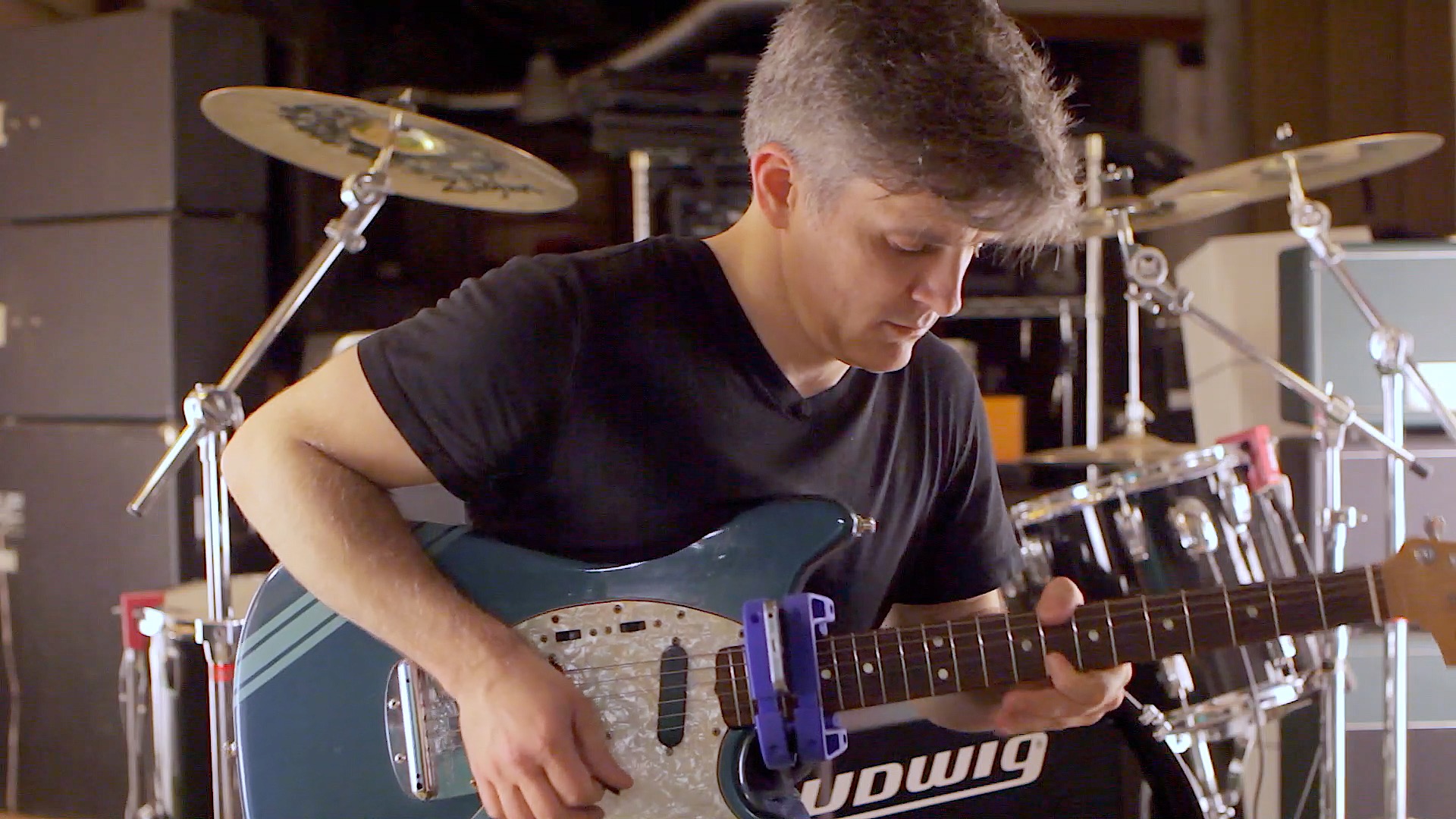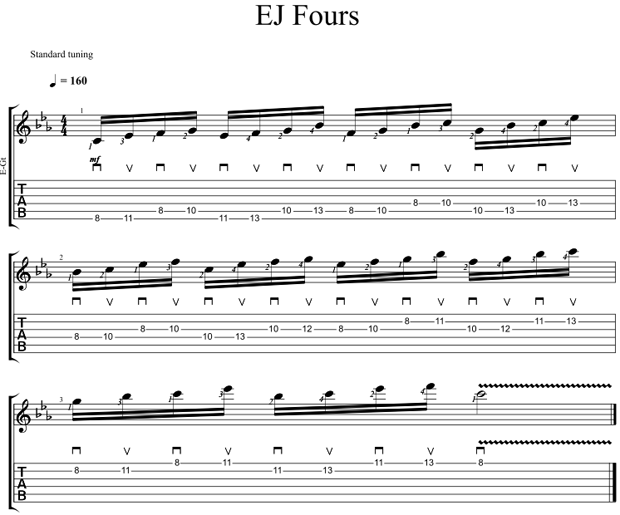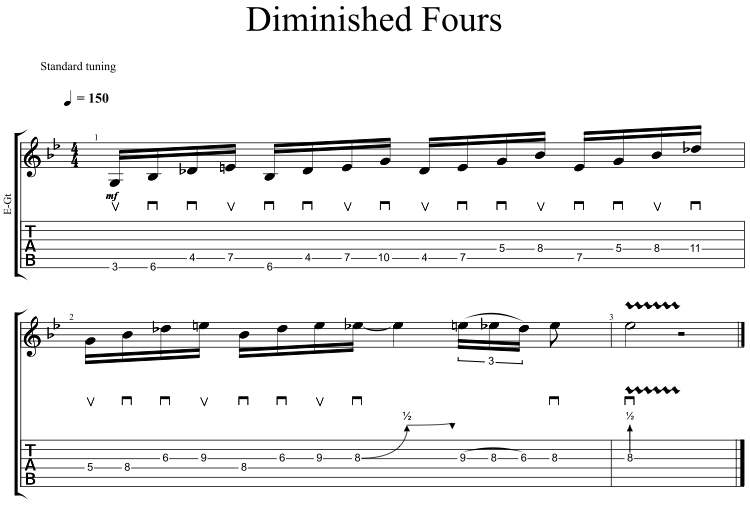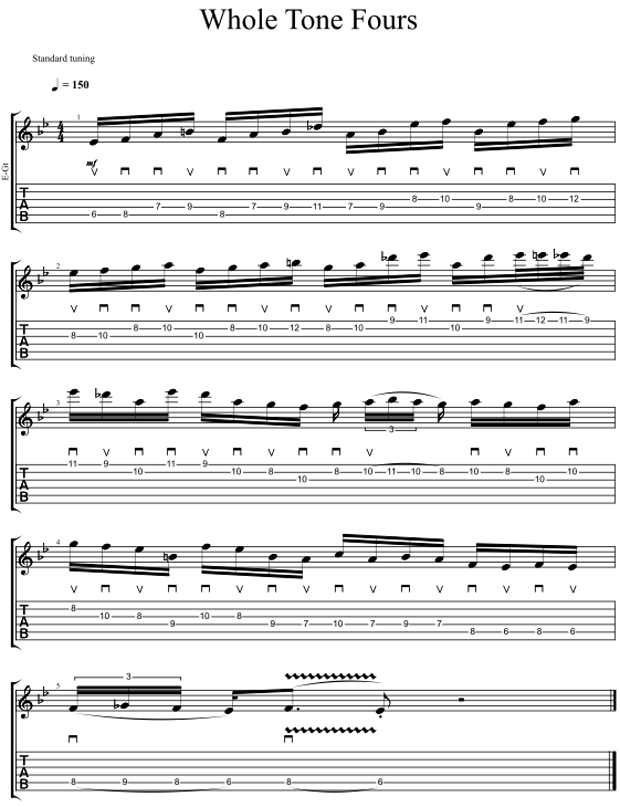Solving the Puzzle of Pentatonic Fours

We recently gave Cracking the Code viewers a cool homework assignment: find a way to play ascending fours, against the pentatonic scale, using the Yngwie Malmsteen and Eric Johnson downward pickslanting system.
The assignment seems simple enough. After all, the pentatonic scale is nearly ubiquitous as a cornerstone of modern rock lead playing. And fours is a common rhythmic grouping, especially considering that most rock songs are written in 4/4 time.
As a result, we hear pentatonic fours patterns in rock leads all the time, especially in keyboard and horn parts. Just not very often on guitar!
In fact, if we make a mental list of the most famous pickers of the last 50 years, I can think of none of them who play sequential pentatonic fours, fully picked, across the neck, at elite levels of speed and accuracy.
And while I'm sure that out there in internet-land there are talented players who can do it, the fact remains that this feat is simply far less common than we'd expect. And it turns out, there's good reason for this. The complicated picking patterns that occur as we cycle the box in units of four can make life woefully difficult for the picking hand.
On top of this, the barre fingerings that arise as we do this can make it tricky to avoid overlapping notes, which can sound messy on a high gain amp.
Pickslanting to the Rescue
All the latest guitar news, interviews, lessons, reviews, deals and more, direct to your inbox!
But with a basic understanding of downward pickslanting mechanics, we can design a couple of really nice solutions to this problem that pay fantastic creative dividends.
Cracking the Code viewers are already familiar with the downward pickslanting system, where upstrokes are used to switch strings with extreme efficiency. In fact, we've written about this here at GuitarWorld.com before, with respect to both Yngwie Malmsteen and Eric Johnson's use of the technique. In Johnson's case, his legendary accuracy derives from his focus on two-note-per-string picking sequences.
By starting these two-note units on a downstroke, Johnson can ensure that the second note on the string—the final note—is an upstroke. This is critical. In the downward pickslanting system, upstrokes "escape" the strings naturally as a result of the slanted picking movement. As long as that escape happens on the last note of the string, Johnson can transition effortlessly to the next string no matter how fast the picking hand is playing.
By harnessing the power of the escaped upstroke, we can reap instant performance benefits:

The key to this approach is position shifting. Each two-string, four-note unit is perfectly efficient thanks to the escaped upstroke. So by simply shifting up to the next position, we can maintain our two-note-per-string structure, and achieve the exact same efficiency for the next repetition of the sequence. After the second repetition, we simply move up to the next pair of strings, and repeat. Straightforward and elegant.
The challenge of this approach is the fretting. By using three-note-per-string fingerings, we encounter third- and fourth-finger combinations that you may not be used to. But mastering these dramatically reduces the fatigue of always reusing the same two fingers. It also completely eliminates the error-prone jumping of the fretting hand between positions. Baking this coordination into your long-term memory is great exercise. And it also opens the door to all kinds of cool patterns and sequences you might come up with in the process.
Volcano Fours
In Season 2 Episode 2 of Cracking the Code, "Inside the Volcano," we encountered Malmsteen's famous expansion of the downward pickslanting system: sweeping. By using a single downstroke to move to the next higher string, we can completely sidestep the athletic challenges of switching strings with alternate picking. Because the pick is slanted downward, sweeping in the Malmsteen system only happens only during melodically ascending string changes. That works out fine for us, since that's precisely the direction in which our pentatonic sequence is moving:

By combining Yngwie's mastery of sweeping with the escaped upstroke of downward pickslanting, we experience a double-dip boost in efficiency. The first unit of four uses a downward sweep for the string change. The second unit uses an escaped upstroke and a sweep. So in other words, we have a formula: sweeping in the ascending direction, and alternate picking in the descending direction.
This is the Malmsteen way. It's the key to the stunning speed of the "Volcano Lick," which we examine in "Inside the Volcano," and it's the secret to Malmsteen's seemingly impossible accuracy in playing ascending scalar lines. Although it looks complicated on the surface, this Volcano-style solution is actually even easier to execute than the pure alternate picking method of the Eric Johnson-style approach.
Gone are the awkward third- and fourth-finger fretting combinations. In fact, although the Volcano solution relies on three-note-per-string stretches, it only does so only every other repetition, instead of every repetition. The fact that sweeping makes two of the string changes nearly effortless is simply the icing on the cake.
Whole Diminished Power
These clever mechanical solutions are only two of the many possibilities that arise as a result of pickslanting thinking. But how can we make use of all this picking power? Well, if the pentatonic scale is just a two-note-per-string fingering, then we should be able to apply these picking patterns to almost any idea that we fret using two notes per string. How about diminished?

Very cool. Malmsteen is famous for his use of diminished sweep shapes on the top three strings. But here we've discovered a way to take this exotic tonality across the entire guitar. No how about whole tone?

Also very cool. Like the diminished scale, the symmetrical nature of whole tone fingerings make them ideal for sequential ideas. And these shapes are even easier to reach than the diminished fingerings thanks to their more compact fretboard spans. But there's no need to play favorites.
All three of these ideas—pentatonic, diminished and whole tone—can live happily together in a modern blues context. Here's what that can sound like:



Diminished and whole tone sounds work well with blues riffing because of their inherent tritone intervals. By lining these intervals up with the tritones that already exist in the blues scale—between the root and the flatted fifth, for example—you can generate some really cool fusion sounds that seem to protrude just beyond what the listener expects.
Mixing in little bits of the sequenced feel takes this one step further as a kind of counterpoint to the looser, funkier feel of box-style blues riffing. And that's really the point. In Cracking the Code, mechanical explorations are never academic. Instead, finding interesting mechanical concepts and matching them with interesting tonalities is an incredibly powerful source of creativity.
If this kind of discovery appeals to you, you'll find much more of it in Cracking the Code, the show, as well as in our Masters in Mechanics Series, a monthly subscription series exploring an even wider array of fascinating topics at the intersection of mechanics and music.
Troy Grady is the creator of Cracking the Code, a documentary series with a unique analytical approach to understanding guitar technique. Melding archival footage, in-depth interviews, painstakingly crafted animation and custom soundtrack, it’s a pop-science investigation of an age-old mystery: Why are some players seemingly super-powered?
Troy Grady is the creator of Cracking the Code, a documentary series with a unique analytical approach to understanding guitar technique. Melding archival footage, in-depth interviews, painstakingly crafted animation and custom soundtrack, it’s a pop-science investigation of an age-old mystery: Why are some players seemingly super-powered?
